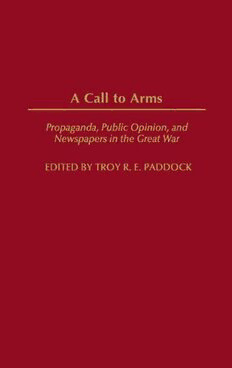
A Call to Arms: Propaganda, Public Opinion, and Newspapers in the Great War PDF
Preview A Call to Arms: Propaganda, Public Opinion, and Newspapers in the Great War
A Call to Arms Recent Titles in Perspectives on the Twentieth Century Minority Protection in Post-Apartheid South Africa: Human Rights, Minority Rights, and Self-Determination Kristin Henrard Depression to Cold War: A History of America from Herbert Hoover to Ronald Reagan Joseph M. Siracusa and David G. Coleman Making the World Like Us: Education, Cultural Expansion, and the American Century Liping Bu Trans-Pacific Relations: America, Europe, and Asia in the Twentieth Century Richard ]ensen, Jon Davidann, and Yoneyuki Sugita, editors From Adversaries to Partners? Chinese and Russian Military Cooperation after the Cold War Ming-Yen Tsa The German Question since 1919: An Introduction with Key Documents Stefan Wolff Tricolor and Crescent: France and the Islamic World William E. Watson American Soldiers Overseas: The Global Military Presence Anni P. Baker A Call to Arms Propaganda, Public Opinion, and Newspapers in the Great War EDITED BY TROY R. E. PADDOCK Perspectives on the Twentieth Century Edward R. Beauchamp, Series Adviser P R A E G E R Westport, Connecticut LLoonnddoonn Library of Congress Cataloging-in-Publication Data A call to arms : propaganda, public opinion, and newspapers in the Great War / edited by Troy R. E. Paddock. p. cm. (Perspectives on the twentieth century, ISSN 1538-9626) Includes bibliographical references and index. ISBN 0-275-97383-2 (alk. paper) 1. World War, 1914-1918—Propaganda. 2. World War, 1914-1918—Public opinion. 3. Press and propaganda. 4. War—Press coverage. I. Paddock, Troy R. E. II. Series. D639.P6C35 2004 940.4'88—dc22 2004023026 British Library Cataloguing in Publication Data is available. Copyright © 2004 by Troy R. E. Paddock All rights reserved. No portion of this book may be reproduced, by any process or technique, without the express written consent of the publisher. Library of Congress Catalog Card Number: 2004023026 ISBN: 0-275-97383-2 ISSN: 1538-9626 First published in 2004 Praeger Publishers, 88 Post Road West, Westport, CT 06881 An imprint of Greenwood Publishing Group, Inc. www.praeger.com Printed in the United States of America The paper used in this book complies with the Permanent Paper Standard issued by the National Information Standards Organization (Z39.48-1984). 109 987654322 Contents Acknowledgments vii Series Foreword by Edward R. Beauchamp ix Introduction: Newspapers, Public Opinion, and Propaganda 1 1. A Clash of Cultures: The British Press and the Opening of the Great War 15 Adrian Gregory 2. "The Eagle Soars over the Nightingale": Press and Propaganda in France in the Opening Months of the Great War 51 Michael Nolan 3. The Russian Press and the "Internal Peace" at the Beginning of World War I 91 Eric Lohr 4. German Propaganda: The Limits of Gerechtigkeit 115 Troy R. E. Paddock 5. The Empire without Qualities: Austro-Hungarian Newspapers and the Outbreak of War in 1914 161 Andrea Orzojf Closing Observations on Newspapers, Propaganda, and the Great War 199 Index 207 About the Contributors 211 This page intentionally left blank Acknowledgments First of all, I would like to thank Adrian Gregory, Eric Lohr, Michael Nolan, and Andrea Orzoff for their participation in this project. Series edi tor Edward Beauchamp and Heather Staines, the editor at Greenwood Press, have been supportive and patient throughout this extended process and have my deepest appreciation. I would also like to thank the staff at the Institut fur Zeitungsforschung in Dortmund, Germany, for their assis tance, and the Council on European Studies at Yale University for provid ing access to the Sterling Memorial Library. My colleagues at Southern Connecticut State University—Stephen Amerman, Polly Beals, David Bello, Nikos Chrissidis, Steven Judd, Bruce Kalk, and Michele Thomp son—offered constructive criticism at various stages of the project and have my thanks. I would also like to thank Southern Connecticut State University for providing funding for summer research and Dean Donna- Jean Fredeen for granting me release time to work on this project. Most important of all, I want to thank my wife, Mary, for her support, encour agement, and help in transforming my German translations into readable English, and my son, Mack, for not caring about any of this and remind ing me that there are some things more important than a missed deadline. This page intentionally left blank Series Foreword Whoever first coined the phrase, "When the siecle hit the fin," described the twentieth century perfectly! The past century was arguably a century of intellectual, physical, and emotional violence unparalleled in world his tory. As Haynes Johnson of the Washington Post has pointed out in his The Best of Times (2001), "since the first century, 149 million people have died in major wars; 111 million of those deaths occurred in the twentieth cen tury. War deaths per population soared from 3.2 deaths per 1,000 in the sixteenth century to 44.4 per 1,000 in the twentieth.1 Giving parameters to the twentieth century, however, is no easy task. Did it begin in 1900 or 1901? Was it, as in historian Eric Hobsbawm's words, a "short twentieth century," that did not begin until 1917 and end in 1991?2 Or was it more accurately the "long twentieth century," as Giovanni Arrighi argued in The Long Twentieth Century: Money, Power, and the Origins of Our Times?3 Strong cases can be made for all of these constructs and it is each reader's prerogative to come to his or her own conclusion. Whatever the conclusion, however, there is a short list of people, events, and intellectual currents found in the period between the nineteenth and twenty-first centuries that is, indeed, impressive in scope. There is little doubt that the hopes represented by the Paris Exhibition of 1900 repre sented the mood of the time—a time of optimism, even Utopian expecta tions, in much of the so-called civilized world (which was the only world that counted in those days). Many saw the fruits of the Industrial Revo lution, the application of science and technology to everyday life, as hav ing the potential to greatly enhance life, at least in the West.
